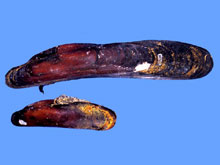
Vulcanolepas osheai, a species of stalked barnacle common on Brothers seamount. Click image for larger view.
A Fascinating Biology
Malcolm Clark
Principle Scientist (Deepwater Fisheries)
National Institute of Water and Atmospheric Research
Wellington, New Zealand
The geological significance of tectonic plate boundaries and spreading or subduction zones has been recognized for many decades. However, the biological importance dates from 1977, when deep-sea hydrothermal vents were first observed near the Galapagos Islands. Associated with these seafloor hot spring vents were dense concentrations of animals -oases in the so-called desert of the deep sea. These communities do not rely directly on sunlight and photosynthetic organisms, but on chemosynthetic microbes that convert the sulphur-rich vent fluids to useful energy. Vent animals have become adapted to deal with high temperature (up to several hundred degrees celcius), as well as chemicals and heavy metals in concentrations that are poisonous to most animals. Consequently vents (as well as seeps of highly concentrated chemical compounds such as methane where similar processes operate) have become the focus of greater biological investigation in recent years, especially by the use of manned submersibles allowing these often localized sites to be more readily found. Of particular interest to scientists are how such life evolved, why different hydrothermal species thrive in different parts of the world, how many species are restricted to one vent site, or how can species spread using vents on undersea volcanoes as “stepping stones” across the deep sea.

Gigantidas gladius, a newly described species of mussel that reaches over a foot in length, and forms dense beds near vent sites on Rumble III seamount. Click image for larger view.
Discovery of hydrothermal vent animals around New Zealand is recent, dating from the late 1980s-early 1990s. Areas of the continental shelf and slope in the inner Bay of Plenty yielded our first glimpse, but with more exploration by NIWA and GNS scientists of seamounts north along the Kermadec Ridge, the number of known sites rapidly grew. The undersea volcanoes of Rumble III, Rumble V, Brothers, Macaulay, Giggenbach, and Monowai have revealed new species of barnacle, mussel, clam, worm and shrimp. However, sampling has been sporadic and has generally consisted of only a few short camera tows or dredges on each of these seamounts, although a few submersible dives were made by a Japanese-NZ team on Brothers Volcano in 2004. Many more species await discovery, and as our knowledge of the community composition improves, we can start to evaluate how the pieces of the jigsaw puzzle fit together and better understand how these hydrothermal systems function.
The submersible dives and remote-operated-vehicle work planned on this expedition cover up to 8 seamounts spread along the southern Kermadec Ridge. This will give a tremendous amount of new information on what animals live on and near the vent sites, and hopefully will give sufficient data on their distribution for us to determine how the fauna on neighboring seamounts is related, and also how the Kermadec Ridge fauna is linked to the Lau Basin vent systems (located further north towards Fiji).
Sign up for the Ocean Explorer E-mail Update List.


























